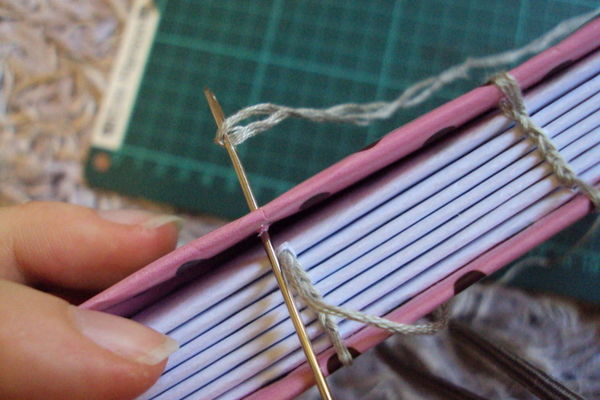Sew a coptic binding
Sew a simple Coptic-bound sketchbook using paper signatures, cardboard covers, needle, and strong thread with adult help to learn stitching.


Step-by-step guide to sew a Coptic binding
How to Coptic Stitch - Step by Step Bookbinding Tutorial (Kettle stitch & easy back cover!)
Step 1
Gather all your materials and find a flat workspace with good light.
Step 2
Stack 4 sheets of paper and fold them in half to make one signature.
Step 3
Repeat folding to make two more signatures so you have three signatures total.
Step 4
Cut two cardboard cover pieces so each is about 1/8 inch larger than the folded signatures on all sides.
Step 5
Use the ruler and pencil to mark four evenly spaced sewing stations along the folded edge of each signature.
Step 6
Mark the same four sewing stations along the inner edge of each cardboard cover so they line up with the signatures.
Step 7
With adult help, use the awl to punch holes at every mark through all signatures and through both covers.
Step 8
Cut a length of thread about four times the height of the closed book, thread the blunt needle, and tie a knot at the end.
Step 9
Place the first signature against the inside of the front cover aligning the holes and secure them with binder clips.
Step 10
Start sewing the first signature to the front cover by making a chain loop at the bottom hole and continue the same loop sequence through each hole up to the top so the signature is attached to the cover.
Step 11
Slide the second signature under the tail of the thread, align its holes, and sew it to the first signature using the same chain-link stitch from bottom to top so the signatures are linked.
Step 12
Repeat sewing and linking for the remaining signature and finish by attaching the last signature to the back cover with the same chain-link method, then tie a secure knot and trim excess thread.
Step 13
Take a photo of your finished Coptic-bound sketchbook and share your creation on DIY.org
Final steps
You're almost there! Complete all the steps, bring your creation to life, post it, and conquer the challenge!

Help!?
What can we use instead of an awl, blunt needle, or cardboard if they're hard to find?
Use a large nail or pushpin (with adult help) in place of the awl to punch holes, a tapestry or plastic yarn needle instead of the blunt needle, and swap the cardboard covers for cereal-box chipboard or thin matboard cut about 1/8 inch larger than the folded signatures.
My holes or sewing look messy—how do I fix misaligned holes or slipping signatures during sewing?
If holes are misaligned repunch them using the ruler marks and awl through the stacked signature, keep everything steady with binder clips as in the instructions, and always slide each new signature under the tail of thread before continuing the chain-link stitch to prevent slipping.
How can I adapt this Coptic binding activity for younger or older kids?
For younger children have an adult pre-punch holes and pre-cut covers and let them sew with thick yarn and a large plastic needle on a two-signature book, while older kids can add more signatures, use thinner waxed linen thread, and follow the full four-station chain-link sequence for a larger sketchbook.
What are some ways to enhance or personalize the finished Coptic-bound sketchbook?
Decorate the cardboard covers with paint, collage, or fabric before assembling, glue in endpapers between covers and the first/last signatures, use colored waxed linen so the chain links show, or add small beads to the final knot before trimming the excess thread.
Watch videos on how to sew a Coptic binding
Sew Your Own Book! Easy to Follow Coptic Stitch Tutorial
Facts about bookbinding for kids
✂️ Sturdy covers can be made from recycled cardboard, making this project cheap, eco-friendly, and great for decorating.
🎨 A lay-flat sketchbook is perfect for drawing across a two-page spread without the middle seam getting in the way.
🧵 Bookbinding with a single strong thread teaches fine motor skills, counting stitches, and careful hand-eye coordination.
📚 Coptic-bound books date back many centuries and are one of the earliest codex-style bindings — they lie flat when opened.
🪡 The Coptic stitch creates a visible chain-like stitching along the spine, so the sewing becomes a decorative feature.
How do you sew a simple Coptic-bound sketchbook?
What materials do I need to sew a Coptic-bound sketchbook?
What ages is sewing a Coptic-bound sketchbook suitable for?
What are the benefits, safety tips, and variations for a Coptic-bound sketchbook?


One subscription, many ways to play and learn.
Only $6.99 after trial. No credit card required



